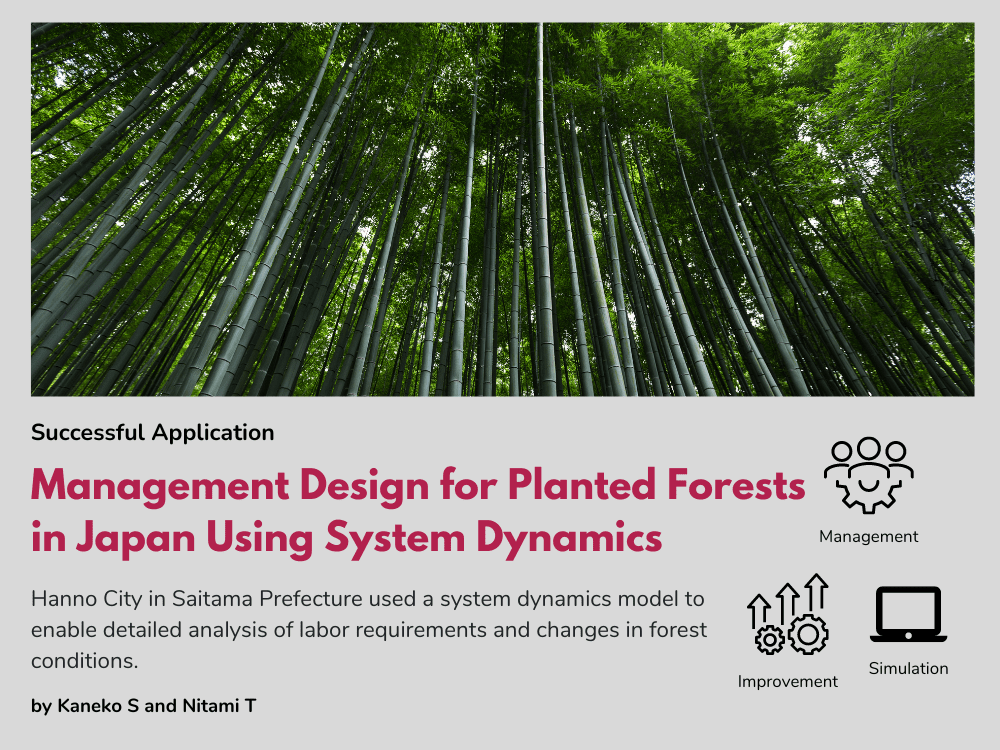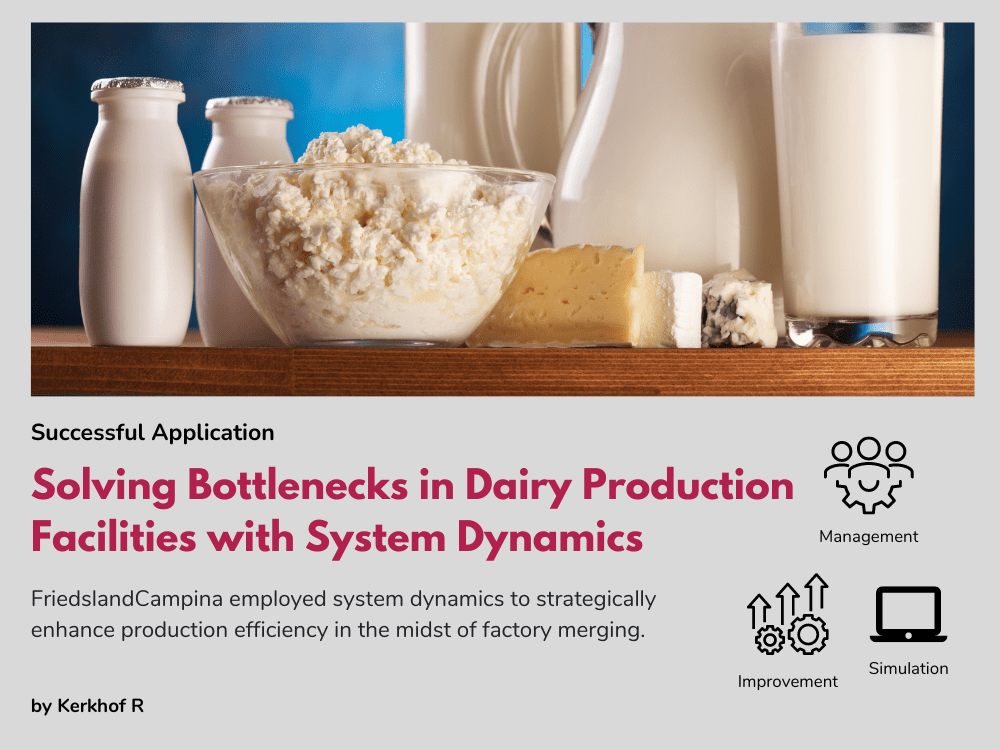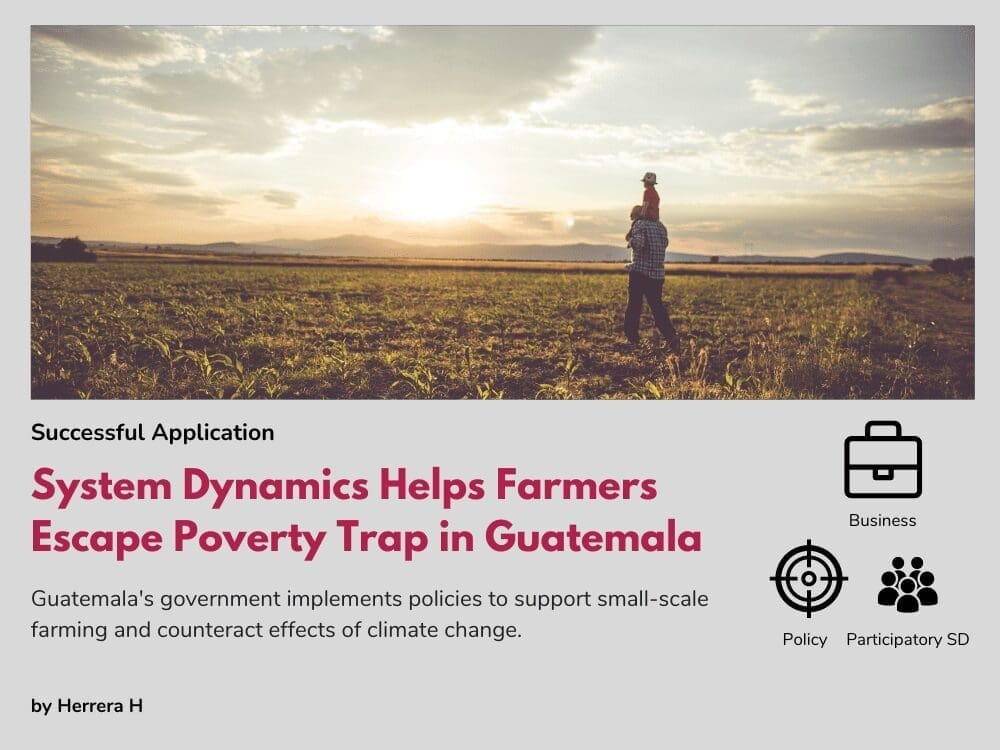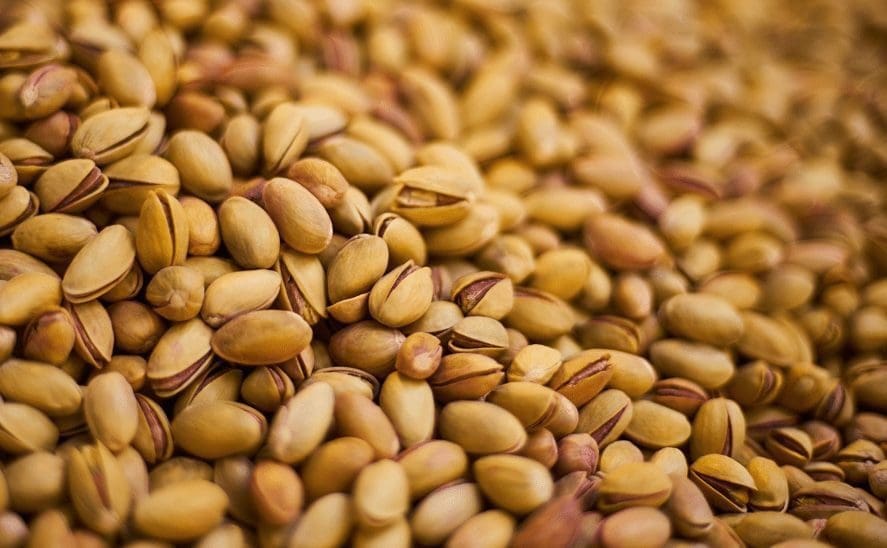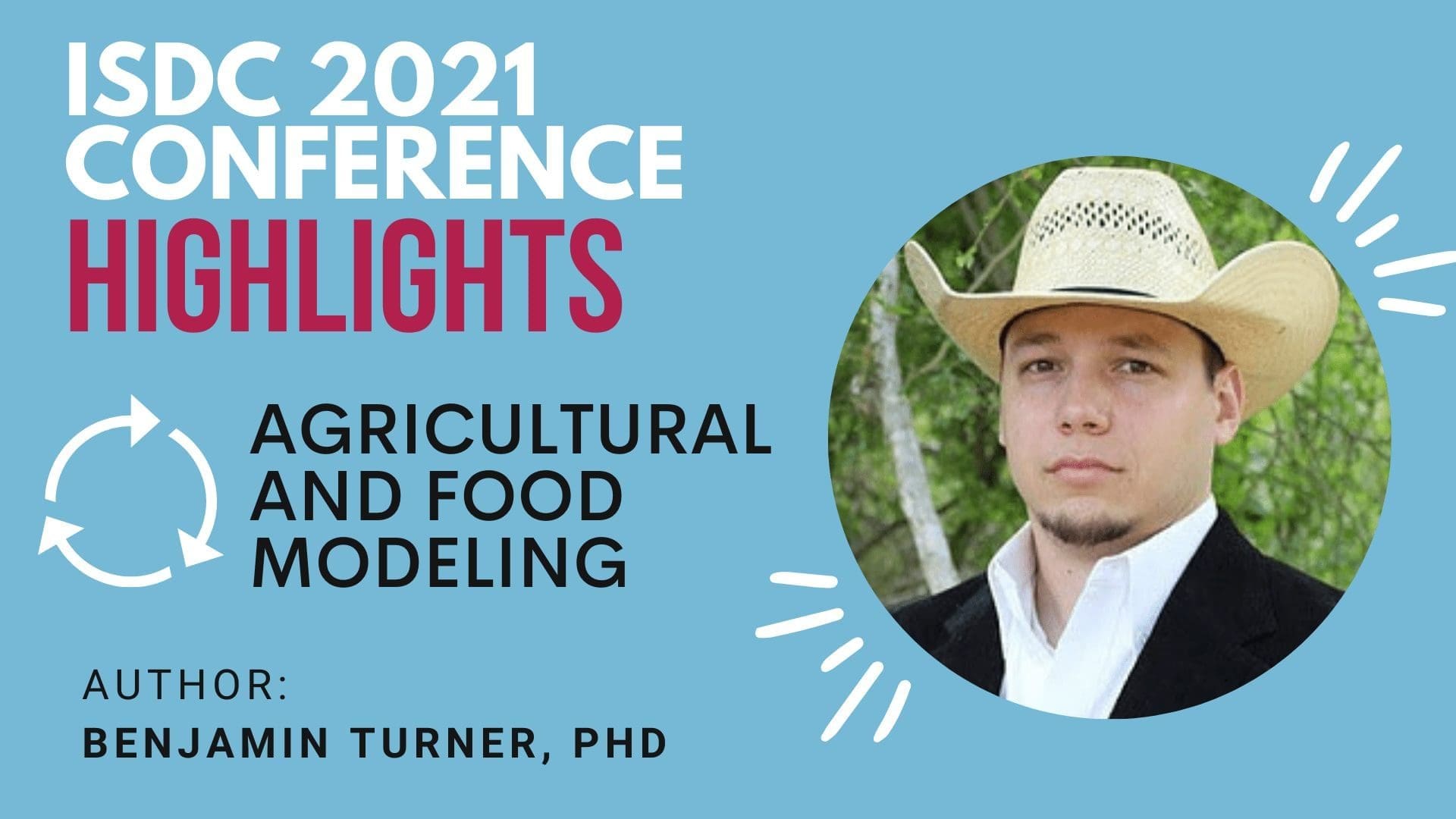Management Design for Planted Forests in Japan Using System Dynamics
EXECUTIVE Summary
-
The simulation model offers a novel approach to sustainable forest management in Japan, enabling detailed analysis of labor requirements and changes in forest conditions.
-
It enables economic benefits such as stable employment, improved financial planning, and enhanced spatio-temporal analysis for 3D visualization of forestry operations.
-
Environmental sustainability is promoted through operations designed to support reforestation, including planting and thinning.
-
This comprehensive tool empowers regional forestry workers and local governments to devise informed, sustainable management plans based on precise forest stand data.
#HannoCity #Sustainability #Forest #Japan
The Problem
The challenge of sustainable forest management lies in accurately assessing and managing forests at the level of individual stands (a term for forest management units). This issue is especially acute in Japan, where forests consist of many small, varied stands, complicating efforts to develop effective management strategies. Traditionally, forest management plans have relied on the experience of local practitioners or rough estimates, which may not be adequate for the following reasons:
1. Predicting Forest Stand Changes: There’s a notable difficulty in forecasting how each stand will evolve over time.
2. Outcome-based Management Planning: There’s a need for a method to create management plans that start with the end in mind, aiming for specific forest conditions.
3. Sustainable Management Practices: Ensuring that forest management is sustainable over the long term is a challenge.
The focus of this case is on Hanno City in Saitama Prefecture, a region with a significant forestry sector and multiple local sawmills. With planted forests nearing the time for harvest, these mills are expected to become increasingly important in the timber production supply chain.
The Solution
The solution to sustainable forest management challenges is centered around a system dynamics (SD) modeling approach, designed to accurately calculate labor inputs required for a range of forestry activities and the resulting changes in forest conditions. This methodology encompasses a suite of management operations, including planting, weeding, improvement cutting, thinning, final cutting for forests aged 50 to 99 years, and long-term cutting for those over 100 years old. An integral component of this model is a carbon emission calculation module, underscoring the approach’s alignment with environmental sustainability.

In the context of Hanno City, this SD model was utilized to create a forest management simulation over a 30-year period. This simulation predicted an average production of 7,174 cubic meters of logs, which were then designated for use as either building timber or fuel. The model intricately simulates the dynamics of tree density and forest stand age by tracking stock (e.g., tree density per unit area), inflow (e.g., planting and natural deaths), and outflow (e.g., removals due to forestry operations). These elements are grounded in initial data from a comprehensive forest stand database, enhancing the accuracy of management planning.
The model’s architecture is notably sophisticated, featuring an ‘Array’ structure that reflects the complexity of managing multiple forest stands, thereby enabling detailed spatial and temporal analyses. It also incorporates static geographic attributes to identify stands eligible for harvest, ensuring the model’s utility in crafting precise and informed management plans. This approach presents a forward-thinking solution for forest management, offering a detailed, scalable tool that aligns productivity with sustainability objectives, leveraging the depth of system dynamics modeling to navigate the complexities of forestry operations.

Outcomes
The implementation of the system dynamics model in forest management facilitates a nuanced understanding of forest stand changes, enabling regional forestry workers and local governments to craft precise management plans. The model’s application yields several key outcomes and impacts:
• Economic Stability and Employment: By optimizing operations, the model supports the creation of stable, long-term employment opportunities within the forestry sector. This optimization ensures a balanced workload, contributing to economic stability for those involved in forest management.
• Financial Management: It provides a robust framework for calculating revenue, income, and costs associated with forest management activities. This capability enables more accurate financial planning and resource allocation, enhancing the economic viability of forestry operations.
• Technological Integration and Visualization: The model facilitates the export of data on spatio-temporal changes in forests to external tools via spreadsheets. This feature allows for the innovative use of 3D visualization technologies, such as Unity, to model forest development and management scenarios visually. Such visualizations can aid in decision-making, stakeholder engagement, and educational outreach.
• Environmental Sustainability: On the environmental front, the model supports the design of operations that prioritize forestation efforts, including planting and thinning. These practices contribute to the sustainability of forest ecosystems by maintaining healthy forest stands and enhancing biodiversity. Additionally, the ability to model carbon emissions helps align forest management practices with broader environmental and climate goals.
• Regional Forestry Planning: The detailed insights provided by the model into forest stand changes are invaluable for designing sustainable regional forestry strategies. This detailed level of information supports targeted interventions and long-term planning efforts, ensuring that forestry practices contribute positively to both local economies and the environment.
By addressing both financial and environmental aspects of forest management, this model stands as a pivotal tool for advancing sustainable forestry practices, aligning with global sustainability targets and local economic needs.
Do you want to know more?
Connect with Shunsuke Kaneko.
OTHER SUCCESSFUL APPLICATIONS
System Dynamics Helps Evaluate Anticipatory Action on Cholera Outbreaks
Humanitarian agencies encourage anticipatory action in disaster response to cholera outbreaks in the Democratic Republic of Congo.
Management Design for Planted Forests in Japan Using System Dynamics
Hanno City in Saitama Prefecture used a system dynamics model to enable detailed analysis of labor requirements and changes in forest conditions.
Solving Bottlenecks in Dairy Production Facilities with System Dynamics
FriedslandCampina employed system dynamics to strategically enhance production efficiency in the midst of factory merging.
Upcoming Events

2024 International System Dynamics Conference
The International System Dynamics Conference is coming to Bergen! Save the date: August 4-8, 2024. We hope to see you there! #ISDC2024
Recent Posts
How Did En-ROADS Get 755,000 users? Lessons on Modeling, Interface Design, and Facilitation
This article discusses the En-ROADS climate model, detailing its robust modeling, intuitive interface design, effective facilitation, and strategic policy engagement for global impact.
Society Governance Updates
New System Dynamics Society leadership
Call for Presenters: Seminar Series
Share your insights in the System Dynamics Society Seminar Series. Submit your proposal and join a global community of experts
Join us
OTHER SUCCESSFUL APPLICATIONS
System Dynamics Helps Evaluate Anticipatory Action on Cholera Outbreaks
Humanitarian agencies encourage anticipatory action in disaster response to cholera outbreaks in the Democratic Republic of Congo.
Management Design for Planted Forests in Japan Using System Dynamics
Hanno City in Saitama Prefecture used a system dynamics model to enable detailed analysis of labor requirements and changes in forest conditions.
Solving Bottlenecks in Dairy Production Facilities with System Dynamics
FriedslandCampina employed system dynamics to strategically enhance production efficiency in the midst of factory merging.
Recent Posts
How Did En-ROADS Get 755,000 users? Lessons on Modeling, Interface Design, and Facilitation
This article discusses the En-ROADS climate model, detailing its robust modeling, intuitive interface design, effective facilitation, and strategic policy engagement for global impact.
Society Governance Updates
New System Dynamics Society leadership
Call for Presenters: Seminar Series
Share your insights in the System Dynamics Society Seminar Series. Submit your proposal and join a global community of experts
Upcoming Events

2024 International System Dynamics Conference
The International System Dynamics Conference is coming to Bergen! Save the date: August 4-8, 2024. We hope to see you there! #ISDC2024
Solving Bottlenecks in Dairy Production Facilities with System Dynamics
EXECUTIVE Summary
-
FrieslandCampina faced potential bottlenecks in production due to the merging of two factories. They hired SD&Co which employed system dynamics simulation models to predict and manage these issues effectively, ensuring smooth operational integration.
-
The project led to strategic changes, such as optimizing algorithms for pallet selection and adding a conveyor belt system, thereby enhancing efficiency without the need for extensive physical expansion of facilities.
-
The implemented changes have prepared FrieslandCampina to handle increased production volumes and maintain efficiency even in scenarios of partial factory downtime, demonstrating a successful adaptation to the merger’s demands.
#FriedslandCampina #SD&Co #Diary #Netherlands
The Problem
FrieslandCampina, a Dutch cooperative, specializes in transforming milk from dairy farmers into a wide array of dairy products. They were undertaking a significant project: merging two of their production facilities. This merger was anticipated to introduce new challenges, particularly in the filling and palletizing stages, as well as in the operations of their fully automated warehouse. The project was handled by SD&Co and their primary goal was to foresee potential bottlenecks under various post-merger production scenarios. Identifying these potential bottlenecks was crucial to ensure a smooth transition and maintain efficiency. Additionally, SD&Co was tasked with devising strategies to address these bottlenecks in the most effective and efficient manner possible, keeping in mind the operational workflow and the increased scale of production due to the merger.

Figure 1 – FrieslandCampina’s production facility
The Solution
FrieslandCampina faced a significant challenge: implementing changes to their factory could take up to two years. This long time frame posed a risk of reduced production output or the possibility of overinvesting in capacity expansion. The complexity of the situation was heightened by the interconnected nature of the factory and warehouse processes, which made it challenging to accurately predict outcomes using traditional tools like spreadsheets.
To navigate these complexities, SD&Co employed a comprehensive approach by developing four distinct simulation models. Each model varied in scope and level of detail, enabling a thorough analysis of a wide range of production scenarios and potential physical modifications to both the factory and the warehouse. These simulations were instrumental in testing the effects of various changes and understanding their impact on the overall operations.
Thanks to these sophisticated simulation models, FrieslandCampina and its suppliers were able to pinpoint the most effective and efficient solutions. They could identify adjustments to the factory and warehouse that would best accommodate the increased volumes resulting from the merger of the factories. This strategic approach allowed for a well-informed decision-making process, ensuring that the adjustments made were optimally aligned with the new operational requirements.
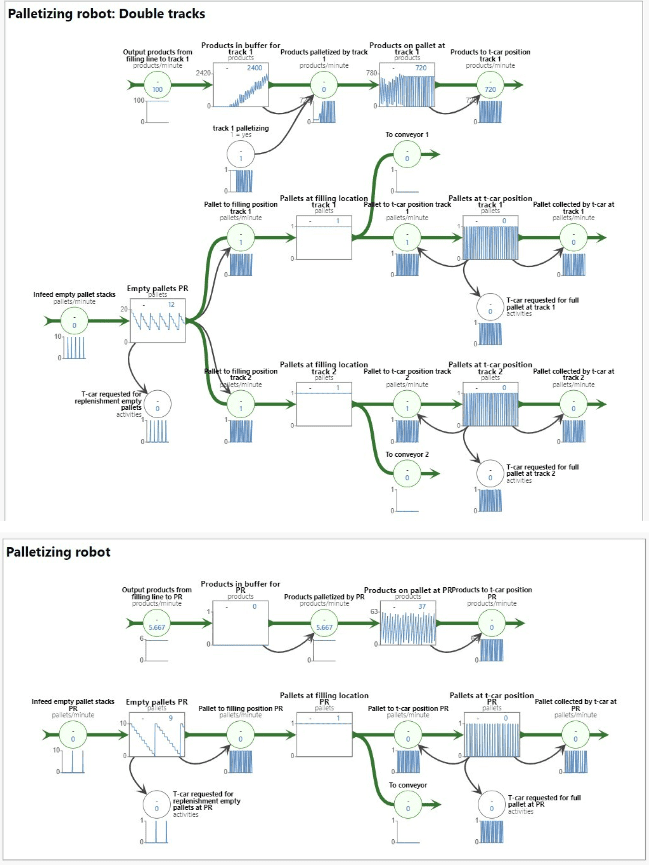
Figure 2 – Examples of sectors of the system dynamics model developed by SD&Co.
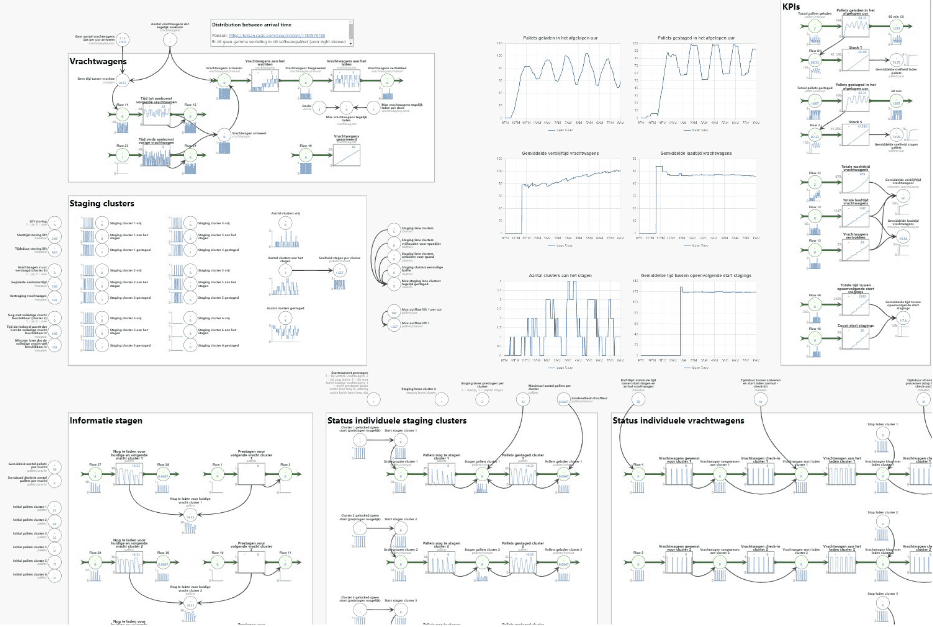
Figure 3 – Overview of simulation dashboards.
Outcomes
In this pivotal project, SD&Co identified the most efficient modifications necessary for the factory and warehouse to handle the increased volumes post-merger. FrieslandCampina, in collaboration with its suppliers, is actively implementing these recommended changes. The key deliverables of this project were the innovative simulation models and a comprehensive presentation detailing the recommended changes. These system dynamics tools provided valuable insights, leading to strategic adjustments within the operational framework of FrieslandCampina.
One significant change was the refinement of the algorithm that manages the selection of pallets for outbound elevators. This adjustment negated the need for physical expansion of the outbound elevators and staging lanes, thereby optimizing existing resources.
Additionally, they introduced a small conveyor belt behind two palletizers to avoid the need for a more extensive and costly redesign of the internal transport system around the palletizers.
Based on the simulation, FrieslandCampina also made a strategic decision to refrain from further investments. The model demonstrated that the new capacity would be adequate across a variety of production scenarios. This included scenarios where parts of the factory might temporarily break down or require maintenance. The project’s outcomes have significantly contributed to the robustness and efficiency of FrieslandCampina’s operations. The implemented changes ensured that the factory and warehouse can smoothly handle increased volumes, while providing a buffer for unforeseen production challenges.
Do you want to know more?
Connect with Roland van de Kerkhof.
OTHER SUCCESSFUL APPLICATIONS
System Dynamics Helps Evaluate Anticipatory Action on Cholera Outbreaks
Humanitarian agencies encourage anticipatory action in disaster response to cholera outbreaks in the Democratic Republic of Congo.
Management Design for Planted Forests in Japan Using System Dynamics
Hanno City in Saitama Prefecture used a system dynamics model to enable detailed analysis of labor requirements and changes in forest conditions.
Solving Bottlenecks in Dairy Production Facilities with System Dynamics
FriedslandCampina employed system dynamics to strategically enhance production efficiency in the midst of factory merging.
Upcoming Events

2024 International System Dynamics Conference
The International System Dynamics Conference is coming to Bergen! Save the date: August 4-8, 2024. We hope to see you there! #ISDC2024
Recent Posts
How Did En-ROADS Get 755,000 users? Lessons on Modeling, Interface Design, and Facilitation
This article discusses the En-ROADS climate model, detailing its robust modeling, intuitive interface design, effective facilitation, and strategic policy engagement for global impact.
Society Governance Updates
New System Dynamics Society leadership
Call for Presenters: Seminar Series
Share your insights in the System Dynamics Society Seminar Series. Submit your proposal and join a global community of experts
Join us
OTHER SUCCESSFUL APPLICATIONS
System Dynamics Helps Evaluate Anticipatory Action on Cholera Outbreaks
Humanitarian agencies encourage anticipatory action in disaster response to cholera outbreaks in the Democratic Republic of Congo.
Management Design for Planted Forests in Japan Using System Dynamics
Hanno City in Saitama Prefecture used a system dynamics model to enable detailed analysis of labor requirements and changes in forest conditions.
Solving Bottlenecks in Dairy Production Facilities with System Dynamics
FriedslandCampina employed system dynamics to strategically enhance production efficiency in the midst of factory merging.
Recent Posts
How Did En-ROADS Get 755,000 users? Lessons on Modeling, Interface Design, and Facilitation
This article discusses the En-ROADS climate model, detailing its robust modeling, intuitive interface design, effective facilitation, and strategic policy engagement for global impact.
Society Governance Updates
New System Dynamics Society leadership
Call for Presenters: Seminar Series
Share your insights in the System Dynamics Society Seminar Series. Submit your proposal and join a global community of experts
Upcoming Events

2024 International System Dynamics Conference
The International System Dynamics Conference is coming to Bergen! Save the date: August 4-8, 2024. We hope to see you there! #ISDC2024
System Dynamics Helps Farmers Escape Poverty Trap in Guatemala
EXECUTIVE Summary
Guatemala holds the 4th highest global ranking for chronic malnutrition, and climate change is intensifying the challenges subsistence farmers face in providing food for their families. Utilizing a System Dynamics model facilitated meaningful discussions among various stakeholders and government entities, ultimately leading to the provision of strategic resources, such as livestock and expert guidance, for 152 families. This support enabled farmers to break free from the poverty trap and make valuable investments in their agricultural endeavors.
The System Dynamics model effectively illustrated the interplay between numerous variables, empowering farmers to comprehend and take control of key leverage points essential for their well-being and prosperity.
#Food security #Farmers #Agriculture #Guatemala
The Problem
Guatemala faces a staggering 55% prevalence of chronic malnutrition (a widely recognized indicator of food insecurity) in rural areas and ranks as 4th worst globally. Climate change is amplifying the difficulties subsistence farmers in Guatemala face in providing food for their families. Although climate change affects all food producers in various ways, subsistence farmers are especially vulnerable due to their limited access to irrigation and crop insurance, which could help mitigate the effects of fluctuating weather conditions. Furthermore, because subsistence farmers depend on their own production to feed themselves and their families, low yields and crop loss often result in malnutrition and starvation.
This underscores the need to understand how local farmers can collaborate and work with both local and central governments to enhance their food security.

The Solution
The model was developed using Group Model Building (GMB) and stakeholder engagement in two distinct communities. In each case, we collaborated with farmers and representatives from central and local governments to create causal loop diagrams that illustrated the primary relationships within their respective food systems and the variables influencing food security resilience in the face of climate change. This understanding was then converted into quantitative System Dynamics (SD) models, which facilitated discussions regarding potential policies.
The model comprises five main components:
-
Maize local market: This component captures the primary dynamics of the local market using a traditional commodity model.
-
Households: This element represents the dynamics affecting household cash availability and purchasing power, with revenues generated from maize production, livestock, and other activities.
-
Livestock: This component illustrates the primary dynamics of livestock (specifically poultry) production on local farms.
-
Soil: This part demonstrates the dynamics of organic nitrogen and organic carbon in the soil.
-
Water and irrigation: This component captures the infrastructure used for irrigation and exogenous variables like rainfall.
The model features three main feedback loops:
-
Commercial agriculture (R1): Revenue from maize increases household cash, which enhances their ability to invest in farming (such as seeds, fertilizers, and irrigation systems), resulting in improved soil quality and increased water uptake.
-
Poverty trap (R2): A portion of maize production is allocated for self-consumption. The higher the proportion dedicated to self-consumption, the less maize is available for the market, which reduces revenue and subsequently investment in farming. Low investment in farming leads to low yields, further decreasing the amount of maize that can be sold.
-
Reserves driving wellbeing (R3): Higher production rates result in more maize being available for self-consumption, reducing the need to spend money on purchasing food. This increases farmers’ available cash for investing in the next year’s harvest.

Outcomes
The policy recommendations from our study were utilized by local NGOs and government representatives to lobby their representatives in parliament and the Minister of Agriculture (MAGA). As suggested in the report, 152 families were provided with livestock in small quantities and supported by technical experts to develop small production farms.
This demonstrates the compelling nature of using System Dynamics in addressing complex issues, such as food security in the context of climate change. System Dynamics enabled to graphically represented the system through causal loop diagrams, providing a crucial visual aid that facilitated communication with local stakeholders in a way that other modeling approaches, mainly focused on mathematical formulations, could not achieve. Further, the emphasis on stocks in System Dynamics allowed for the effective representation of food stocks and key resources like soil organic matter, while maintaining model simplicity.
OTHER SUCCESSFUL APPLICATIONS
System Dynamics Helps Evaluate Anticipatory Action on Cholera Outbreaks
Humanitarian agencies encourage anticipatory action in disaster response to cholera outbreaks in the Democratic Republic of Congo.
Management Design for Planted Forests in Japan Using System Dynamics
Hanno City in Saitama Prefecture used a system dynamics model to enable detailed analysis of labor requirements and changes in forest conditions.
Solving Bottlenecks in Dairy Production Facilities with System Dynamics
FriedslandCampina employed system dynamics to strategically enhance production efficiency in the midst of factory merging.
Upcoming Events

2024 International System Dynamics Conference
The International System Dynamics Conference is coming to Bergen! Save the date: August 4-8, 2024. We hope to see you there! #ISDC2024
Recent Posts
How Did En-ROADS Get 755,000 users? Lessons on Modeling, Interface Design, and Facilitation
This article discusses the En-ROADS climate model, detailing its robust modeling, intuitive interface design, effective facilitation, and strategic policy engagement for global impact.
Society Governance Updates
New System Dynamics Society leadership
Call for Presenters: Seminar Series
Share your insights in the System Dynamics Society Seminar Series. Submit your proposal and join a global community of experts
Join us
OTHER SUCCESSFUL APPLICATIONS
System Dynamics Helps Evaluate Anticipatory Action on Cholera Outbreaks
Humanitarian agencies encourage anticipatory action in disaster response to cholera outbreaks in the Democratic Republic of Congo.
Management Design for Planted Forests in Japan Using System Dynamics
Hanno City in Saitama Prefecture used a system dynamics model to enable detailed analysis of labor requirements and changes in forest conditions.
Solving Bottlenecks in Dairy Production Facilities with System Dynamics
FriedslandCampina employed system dynamics to strategically enhance production efficiency in the midst of factory merging.
Recent Posts
How Did En-ROADS Get 755,000 users? Lessons on Modeling, Interface Design, and Facilitation
This article discusses the En-ROADS climate model, detailing its robust modeling, intuitive interface design, effective facilitation, and strategic policy engagement for global impact.
Society Governance Updates
New System Dynamics Society leadership
Call for Presenters: Seminar Series
Share your insights in the System Dynamics Society Seminar Series. Submit your proposal and join a global community of experts
Upcoming Events

2024 International System Dynamics Conference
The International System Dynamics Conference is coming to Bergen! Save the date: August 4-8, 2024. We hope to see you there! #ISDC2024
The Pistachio You Eat Is Affecting Growers’ Water in Iran
The Pistachio You Eat Is Affecting Growers’ Water in Iran
Iran and the United States are the leading producers of pistachios in the world, with a joint production of 74% of the world’s total. Rafsanjan, a semi-arid region in Iran, has long been famous for its massive pistachio production, generating nearly $1 billion annually over the past decades. Due to highly subsidized energy and water prices, over 30,000 pistachio growers in Rafsanjan benefit from low production costs, cultivating over 110,000 hectares of orchards.
The high profitability of pistachio production has led to an increase in the number of farmers and overconsumption of limited groundwater resources.
More than 95 percent of water resources in the region are used for pistachio orchards irrigation. In the last 30 years, the average depth of wells went from 20 meters to over 300 meters. Today, Rafsanjan faces a severe water scarcity, the groundwater level has declined dramatically, and orchards are drying up.

Sinkhole from overextraction of water.
Confronted with a trade-off between managing groundwater resources and supporting agricultural activities, the government considers implementing several policies, some of which attempt to support pistachio growers while mitigating water shortages (e.g., water transfer, drip irrigation, and subsidies), while others focus mainly on preserving groundwater resources (e.g., income tax, water pricing, and land purchasing). While each policy can have sizable impacts on agricultural productivity, they also require daunting investments.
For instance, it is estimated that in the past few decades the Iranian government has provided nearly $1 billion in subsidies for pistachio production. In addition, a water transfer policy based on a 300 km infrastructure that could provide Rafsanjan up to 250 million cubic meters of water annually would cost around $2 billion.
A system dynamics model calibrated to over 30 years of data allows us to observe the long-term impact on groundwater resources with a business-as-usual case. Simulation results for joint policies focusing on farmer support show a short-term improvement in groundwater levels, due to higher efficiency, but a longer-term deterioration in groundwater levels, farmers further develop the orchards. That is, a better-before-worse behavior. The improved groundwater conditions in the early years make these policies very attractive to governments; however, they lead to higher water demand and groundwater deterioration than the business-as-usual (no policy intervention) scenario. In contrast, simulation results for the joint policies focusing on groundwater improvement lead to significantly improved groundwater levels, but it does so by limiting agricultural activities.
The system dynamics model developed in our study can serve different purposes. It can serve as the basis to help academics study and explore the dynamics of similar agricultural settings. It can help policymakers quantitatively explore the long-term impact of different policies. Finally, it can serve as the basis for a simplified interactive model to help practitioners increase stakeholders’ understanding of the challenges of managing such complex systems known as common-pool resources.
Akhavan and Gonçalves are coauthors of “Managing the trade‐off between groundwater resources and large‐scale agriculture: the case of pistachio production in Iran”, available on the System Dynamics Review.
Recent Posts
How Did En-ROADS Get 755,000 users? Lessons on Modeling, Interface Design, and Facilitation
This article discusses the En-ROADS climate model, detailing its robust modeling, intuitive interface design, effective facilitation, and strategic policy engagement for global impact.
Society Governance Updates
New System Dynamics Society leadership
Call for Presenters: Seminar Series
Share your insights in the System Dynamics Society Seminar Series. Submit your proposal and join a global community of experts
Upcoming Events

2024 International System Dynamics Conference
The International System Dynamics Conference is coming to Bergen! Save the date: August 4-8, 2024. We hope to see you there! #ISDC2024
Recent Business cases
System Dynamics Helps Evaluate Anticipatory Action on Cholera Outbreaks
Humanitarian agencies encourage anticipatory action in disaster response to cholera outbreaks in the Democratic Republic of Congo.
Management Design for Planted Forests in Japan Using System Dynamics
Hanno City in Saitama Prefecture used a system dynamics model to enable detailed analysis of labor requirements and changes in forest conditions.
Solving Bottlenecks in Dairy Production Facilities with System Dynamics
FriedslandCampina employed system dynamics to strategically enhance production efficiency in the midst of factory merging.
Join us
ISDC 2021 Highlights: Agricultural and food modelers produce a crop of conference contributions
The International System Dynamics Conference (ISDC) convenes practitioners who demonstrate what’s new and developing in their fields with System Dynamics. This section of the WiSDom Blog, “Conference Highlights,” asks system dynamicists to spotlight key presentations and innovations presented at the conference.
– Conference Highlights Editorial Team: Saras Chung, Will Glass-Husain, Jack Homer, Sara Metcalf, and Remco Peters with coordination by Christine Tang
This highlight by Dr. Benjamin Turner spotlights Agriculture and Food modeling work that was presented at the conference. Special thanks to Dr. Remco Peters for his editorial support on this post.
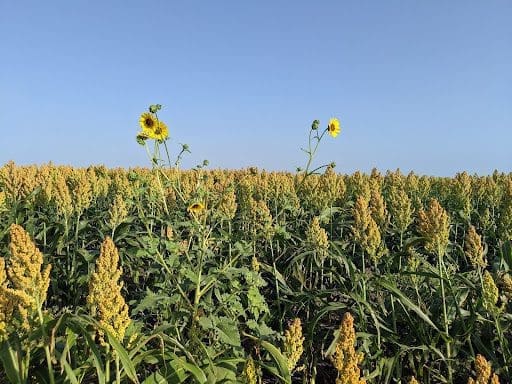
Agricultural and food modelers produce a crop of conference contributions
A society’s ability to produce and distribute food is essential for its survival and unleashing human potential. Given the 21st century challenges of population growth and conserving natural resources, it is crucial to improve the performance of local, national, and global agri-food systems. Many system dynamicists are actively working to address such issues. The 2021 International System Dynamics Conference showcased much of this important work.
For instance, in the global south, food inequity among small-holder farmers is a challenge that was examined by several system dynamicists. Sandra Volken explained that many families in Senegal (West Africa) had to abandon their lands due to declining groundwater tables and the growth of corporate vegetable growers. James Enos presented another example of food inequity in the Upper Nile Basin (Ethiopia and Uganda), where agricultural lands dependent on rainfall put tremendous pressure on small-holder farmers to convert their land for other uses. James illustrated how weather patterns strengthen the oscillatory nature of crop dynamics, leading to a fewer number of crops being grown over larger areas. In the poultry sector, Kelechi Odoemena and his team presented an innovative intervention to address food inequity challenges, which employs a flight-simulator to teach small-scale producers production and financial management principles using key performance indicators (KPIs).
In the global north, important industry-wide challenges are being tackled using System Dynamics. Talks by April Roggio and Alberto Atzori focused on realignment issues causing inequities in the dairy industry. Roggio updated a DYNAMO model originally built in 1976 and demonstrated how competition in a limited market slows down farm ownership transitions, restricts new and young farmers from entering the industry, and accelerates land price appreciation through fragmentation. Atzori and collaborators worked together with the largest milk producers in Italy to develop a general herd management model, calibrated to the best available industry data. Their model is already being used by farm managers to plan milk market deliveries and reduce fluctuating milk and cow inventories.
Some agri-food issues are more ecologically-driven, such as weed herbicide resistance. One of my students, Chris Flores-Lopez, presented a model to address this issue and its impact on long-term cropping system feasibility. His model demonstrated that accumulations of resistant weed seeds in the soil seed bank are only manageable in the short-term (3-5 years) with “status quo” practices of chemical switching. Subsequent tests showed a more hopeful picture. Integrated solutions taking advantage of weed-crop interference pressures can reduce crop losses despite weed seedbank accumulation.
“Farm to fork” challenges at a consumer level were also shared at the conference. Simone Peters and Inge Bleijenbergh’s causal loop diagram of Dutch household food dynamics highlighted the gap of consumer awareness necessary to motivate significant conservation efforts. April Roggio’s team identified ways to model and manage foodshed resiliency. Their work is laying a foundation that warrants much more attention from scientists in our field.
A critical insight emerged from these contributions. Purely technical solutions such as water well installation, switching chemical herbicides, or maximizing milk yield are no longer effective. Instead, future solutions require social or organizational interventions that drive individual decision patterns responsible for reinforcing undesirable or unintended outcomes. This includes revising incentive structures surrounding water resources and livestock markets or implementing more complex cropping systems to build resiliency.
Global Collaboration through the SDS Agriculture and Food Special Interest Group (SIG)
Many of the presenters highlighted above have been actively engaged in the SDS’s Agriculture and Food Special Interest Group (A&F SIG). The success of the SDS’s investment in SIGs may be best illustrated by a recent collaborative effort. Led by Busra Atamer Balkan, the A&F SIG team built a stock-and-flow model, which illustrated how barriers to input supplies and market access were disproportionately affecting smallholder producers during the COVID pandemic. Their resulting framework facilitates dialogue among stakeholders and provides critical modeling structures that I would recommend to anyone studying the impact of COVID on food supplies. This project began as an idea during a SIG meeting, was developed into a conference presentation, and is now peer-reviewed and forthcoming in the International Journal on Food System Dynamics.
The 2021 System Dynamics conference was a tremendous success for transdisciplinary problem-solving. It was remarkable to see parallel challenges in the field despite diverse socio-economic, cultural, or geographic contexts. Discussions during this conference have kick-started several post-conference collaborations and projects. Transdisciplinary approaches to address agri-food system challenges can be accelerated through engagement with System Dynamics Society members and participation in annual conferences or SIGs.
We should all be encouraged that system dynamicists around the world are taking on some of the most important agricultural and food-related issues. I know that I am.
Benjamin Turner
Dr. Benjamin Turner is an Associate Professor of Natural Resource Management at Texas A&M University-Kingsville and co-organizer of the Agricultural and Food Special Interest Group of the System Dynamics Society.

